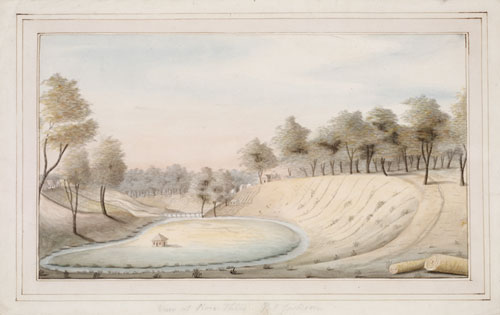First Farms
In 1789, James Ruse, a former convict, produced the first successful wheat harvest in NSW. He didn't yield sufficient grain to make any flour for the colony, but he did produce enough seeds for the next year's crop, which was also successful. This was such a feat in the food-obsessed colony, that Ruse was rewarded for his endeavours with pigs and chickens and the first land grant made by Governor Phillip in NSW. Ruse's 30 acre grant at Rose Hill was aptly named 'Experiment Farm', and led the way for Australia to become one of the most important agricultural nations on the planet.
By the end of 1791, there were over 200 acres in cultivation at the Government Farm, Rose Hill. The success of the Ruse experiment encouraged Governor Phillip to grant land, livestock, agricultural tools, seed and assigned convict workers to settlers and emancipists willing to farm.
 View of the Government Farm, Rose Hill, Parramatta, NSW, ca. 1791.
View of the Government Farm, Rose Hill, Parramatta, NSW, ca. 1791. Watercolour. Artist unknown. DG SV1A / 24
On arrival at Botany Bay, Captain Arthur Phillip had claimed all of the land for the British Crown. As the first Governor of New South Wales, he was able to grant parcels of land to free settlers, soldiers and former convicts. These land grants were usually small, and required the grantee to live on and work the land. This was beneficial because it enabled the grantee to sustain himself, his family and his convict workers and perhaps make some profit by selling his produce. It also meant that fewer people needed to be supported by the Government stores.
> Learn more about early land grants and settlers
An anonymous letter, written in Parramatta in 1819, described the system of agriculture in New South Wales at the time, and discussed settlers issues with the climate as well as successes and failures experienced with various types of crops and livestock.
'There are many Difficulties to encounter; such as a want of Farm Servants; who understand the practice of the modern System of Agriculture; and the want of good husbandry Implements…'
This pageturner requires a web browser with the Flash plugin and JavaScript enabled.
Get the latest Flash player
Letter, regarding the state of agriculture in N.S.W. 15 Feb. 1819. Anonymous Manuscript. A 280
Pastoralist John Macarthur was among the first to import Spanish Merino sheep into NSW for the purpose of breeding fine woolled sheep. Macarthur's breeding program took over 25 years to produce sufficient fleece for export back to England. Wool remained one of Australia's most important agriculture products for over a century.
> Read about John Macarthur's early sheep breeding enterprise
Alexander Berry and his business partner Edward Wollstonecraft were among the earliest and most enterprising cultivators of land in the colony. Setting up the Coolangatta Estate in the Shoalhaven region in the 1820s, this remained an important centre for dairy cattle breeding and butter making until well into the 20th century.
> Find out more about Alexander Berry, the Coolangatta Estate and early agricultural practice in NSW

George Wyndham, who was a pioneer winemaker, settled in the Hunter region of NSW in 1827. His Dalwood Vineyards were a leading producer of wine in the late 1800s.
> Find out more about George Wyndham and early wine production in NSW


